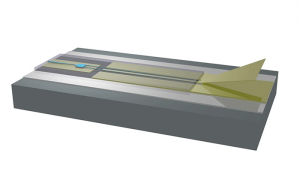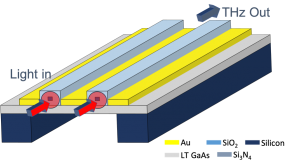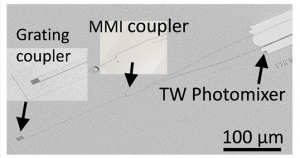A promising photomixer developed at IEMN
 THz sources based on the photodetection of an optical beat of two laser lines by an ultrafast photodetector, also called photomixer, coupled to a THz broadband antenna are very promising because they operate at room temperature, are compact, and above all, can be tuned over frequency ranges reaching several THz. They are therefore perfectly adapted to THz molecular spectroscopy systems for the study of materials, the earth, the sciences of the universe or biological systems. The THz Photonics group has developed a photomixer allowing to reach powers from mW to 1 THz.
THz sources based on the photodetection of an optical beat of two laser lines by an ultrafast photodetector, also called photomixer, coupled to a THz broadband antenna are very promising because they operate at room temperature, are compact, and above all, can be tuned over frequency ranges reaching several THz. They are therefore perfectly adapted to THz molecular spectroscopy systems for the study of materials, the earth, the sciences of the universe or biological systems. The THz Photonics group has developed a photomixer allowing to reach powers from mW to 1 THz.
THz sources based on the photomixing of two laser lines in an ultrafast photodetector are very promising because they operate at room temperature, are potentially compact, low cost, most importantly, broadly tunable in frequency. However, their use is currently limited due to an available power level that remains in the μW range beyond 1 THz.
We have developed a millimeter-length traveling-wave structure paving the way for large active-area (~4000 μm2) photomixing devices capable of sustaining optical pump power in excess of 1 W well beyond the capabilities of standard localized-element devices using small active areas (<50 μm2) required to maintain a level of capacitance (<10 fF) compatible with THz operation.
This type of traveling wave photomixer is not limited by an RC cutoff frequency, but it requires a perfect agreement between the propagation speed of the optical beat (group speed) and the propagation speed of the generated THz waves so that they all have identical phases and interfere constructively. In addition, the THz guide must also have contained propagation losses over distances of the order of a millimeter. Finally, it is necessary to have a photoconductor integrated into the guide with an intrinsic cut-off frequency close to 1 THz.
We present in Fig. 1 the original structure studied here that potentially meets all these challenges. It consists of a dielectric guide (silicon nitride core and silicon oxide cladding) carrying the optical pump beat that is evanescently coupled to a photoconductor composed of a membrane of a sub-picosecond response time photoconductive material (low temperature epitaxial GaAs) and contact electrodes that form a coplanar THz waveguide (THz CPW). Experimentally, the frequency response of a 1 mm long structure, measured using the optical beat produced by two 780 nm-DFB lasers, clearly shows the expected traveling wave signature consisting of a 6 dB decay ending at ~50 GHz when the contra-propagating traveling wave contribution is fully cancelled, followed by a plateau.
The experimental demonstration of traveling wave operation is a first step towards realizing the initial promise of this concept in terms of power level and bandwidth.
Fuanki Bavedila, Charbel Tannoury, Quyang Lin, Sylvie Lepilliet, Vanessa Avramovic, Etienne Okada, Dmitri Yarekha, Marc Faucher, David Troadec, Jean-Francois Lampin, Guillaume Ducournau, Goulchen Loas, Vincent Magnin, and Emilien Peytavit, Development of a Millimeter-Long Travelling Wave THz Photomixer, JOURNAL OF LIGHTWAVE TECHNOLOGY 39, 4700-4709 (2021). https://doi.org/10.1109/JLT.2021.3078226















